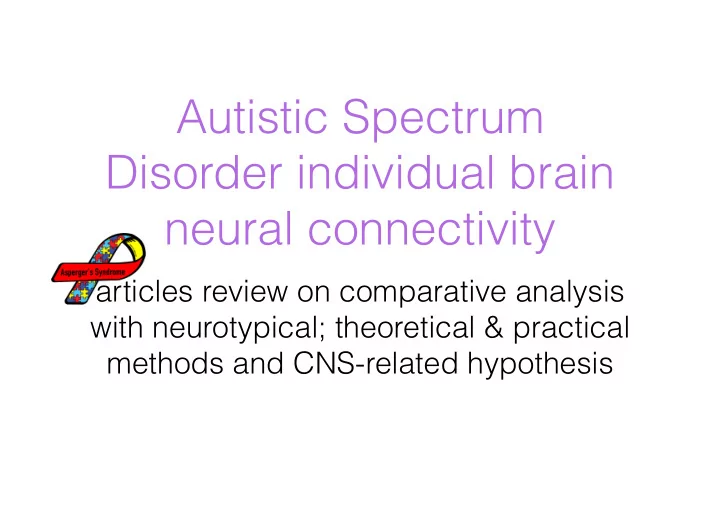

Autistic Spectrum Disorder individual brain neural connectivity articles review on comparative analysis with neurotypical; theoretical & practical methods and CNS-related hypothesis
Vital Abbreviations ToM Theory of Mind MNS Mirror Neuron System NtD Neurotypical Development ASD Autistic Spectrum Disorder ICA Individual Component Analysis fcMRI functional connectivity MRI WCC Weak Central Coherence EF Executive Functioning ROI Region of interest
Abstract • ASD study motivation: ASD researches increasing quantity ASD population increasing rate ASD symptoms unclear reason ASD unique talents lack of ASD learning programmes, especially in Estonia Interest in neural connectivity and information compilation • This project problemacity: Untimely notification Unconditioned intermediation Unreasonable critics Journey Through Autism Wendy Middlemass
Intro Visual and Audible Perception Asynchronicity Multimodal Overload
Simple terms ASD - distributed neural systems disorder NTD - psychologically health persons’ lifelong development Between-network connectivity - cortical or long-distance connectivity Within-network connectivity - local or short-distance connectivity Disrupted cortical connectivity - over-under-within-network connectivity Anatomical (structural) connectivity - white-gray matter integrity Functional (physiological) specialisation - different areas of the brain are specialised for different cognitive functions Functional (physiological) integration - the coordination among brain areas to accomplish a task Effective connectivity - the directionality of information transfer or influence of one region on another, have provided a multilevel characterisation of neural communication
ASD basic symptoms ✦ Impaired ToM: inability to ascribe mental states to oneself and others ✦ Impaired EF: underlies the observable cognitive and social deficits ✦ Impaired WCC: limited ability to integrate representations of stimuli, resulting in a fragmented information-processing style
Relevant Theoretical Methods • Graph theory • Complex and Adaptive Dynamical Systems • Compilation
Developmental Practical Methods ★ fcMRI - systems-level approach to study brain functioning ★ Individual component analysis - component-level approach to study brain functioning ★ Brain-Computer interface (BCI) ★ Machine Learning
BCI game applications for combined neurofeedback and biofeedback treatment for children on ASD • Innovative • Socially interactive • Neural- and body-based feedback • Corresponds directly to the underlying significance of the trained signals and reinforced behavior Closed feedback loop of the Social Mirroring Game
Hypothetical statement BCI game applications for neurobiofeedback with regulated learning level, duration and periodicity on interdisciplinar topics will increase ASD between- network connectivity relieving the most active within- networks’ connections
Perspective ✴ Field: Translational Computational Neuropsychiatry ✴ Research: ASD multimodal learning processes by fMRI ✴ Basic: Qualitative comparative analysis (ASD & NT) ✴ Results: Multimodal integrative learning
References The implications of brain connectivity in the neuropsychology of autism ( Jose O. Maximo, Elyse J. Cadena, and Rajesh K. Kana 2014 ) Developmental changes in large-scale network connective in autism ( Jason S. Nomi, Lucina Q. Uddin 2015 ) Brain hyper-connectivity in children with autism and its links to social deficits ( Kaustubh Supekar, Lucina Q. Uddin, Amirah Khouzam, Jennifer Phillips et all 2013 ) Disrupted Cortical Connectivity as an Explanatory Model for Autism Spectrum Disorder ( Jennifer Drude Borup, Christoffer Bøving Kølgaard 2011 ) Brain-computer interface game applications for combined neurofeedback and biofeedback treatment for children on the autism spectrum ( Elisabeth V.V. Friedrich et all 2014 ) Identification of neural connectivity signature of autism using machine learning ( Gopikrishna Deshpande et all 2013 )
Recommend
More recommend